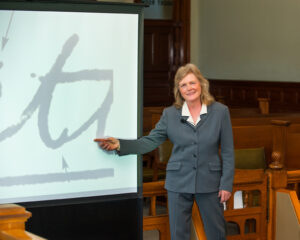Hannah McFarland
Certified Document Examiner & Forensic Handwriting Analyst
Serving Washington State and Beyond
Phone: 360-379-4062| hannah@writeexam.com
“I find her [Hannah McFarland] to have an excellent analytical style. When she makes a comparison, I can actually see what she is talking about. That would be very impressive to a jury.”
-Stephen R. Kay, Head Deputy District Attorney for Los Angeles (read more testimonials here.)
Home
 Summary of Qualifications
Summary of Qualifications
- Certified in 2002 and re-certified four times since then by the National Association of Document Examiners (NADE).
- Testified as an expert witness over 85 times in many venues and jurisdictions including Federal and State Courts in Washington, Oregon, Idaho and Alaska as well as depositions, arbitrations, administrative hearings and other legal proceedings.
- I currently serve on the Executive Board of Directors of the National Association of Document Examiners.
Please contact me for additional information regarding my credentials.
Basic Information about Document Examination
Everyone learns the same alphabet when writing in English but no one exactly follows this alphabet. Everyone develops many variations from the writing system that they learned in school. Thus, the combination of many characteristics in writing, some of which may be rare, are used to identify or eliminate a specific person as having authored a certain signature or other writing.
No one writes exactly the same way twice. In order to conduct a handwriting comparison I need enough genuine handwriting (exemplars) to compare against the questioned handwriting that is at issue.
What I Need in Order to Conduct a Handwriting Comparison
- I need a sufficient amount of known writing, called exemplars, which are used to compare against the questioned writing. Many cases involve questioned signatures. In such cases, five to twenty-five signatures is sufficient.
- A person’s handwriting or handprinting habits can change over time. Consequently,the exemplars and questioned writing should be contemporary with each other. Ideally, both bodies of writing should be written within a year or two of each other.
- I prefer to examine original documents. Photocopies do not reproduce the finer features of handwriting such as pressure and line crossing.
- Examination of originals also eliminates the possibility of a forgery by cutting, pasting and copying a signature onto a document. The absence or loss of an original can itself be suspicious-especially if the destruction or loss of a document is out of character for the situation. Even so, originals are not always available. In such cases, it is common for document examiners to give a qualified opinion when examining non-original documents.
Sometimes the quantity and quality of writing samples available for examination does not exactly meet the criteria listed above. I can still perform the forensic document examination and may amend my opinion accordingly.
When there is a very limited amount of exemplars available, it may become necessary to have a person provide writing samples. Writing samples executed for the purpose of handwriting comparison are known as “request writing.”